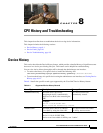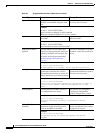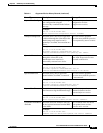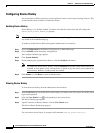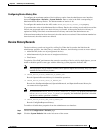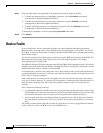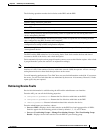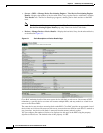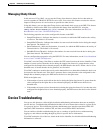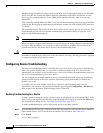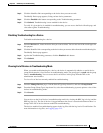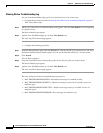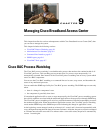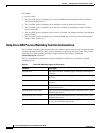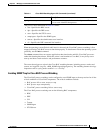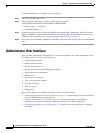
8-9
Cisco Broadband Access Center 3.8 Administrator Guide
OL-27172-01
Chapter 8 CPE History and Troubleshooting
Device Troubleshooting
Managing Chatty Clients
In this release of Cisco BAC, you can use the Chatty client feature to detect devices that make an
excessive number of TR-069 or HTTP file server calls. You can use this feature to reduce the adverse
impact of Chatty devices on services that are provided to other devices.
Using this feature, you can detect the Chatty devices and throttle their access to the DPE. This feature
is enabled by default on the DPE. You can disable this feature from the DPE CLI, using the
chatty-client filter enabled {true | false} command. (For more information, see the Cisco
Broadband Access Center 3.8 DPE CLI Reference.)
The following properties are used to configure this feature on the DPE:
• SampleTimeInterval—Indicates the duration, in seconds, for which the DPE monitors the activity
of a device. The default is 30 seconds.
• SampleHitsToThrottle—Indicates the number of events received from the device during the sample
time interval. The default is 15.
• QuietTimeInterval—Indicates the duration, in seconds, for which the DPE monitors the activity of
a throttled device. The default is 10 seconds.
• QuietHitsToLeaveThrottled—Indicates the number of events received from the device during the
quiet time interval. The default is 5.
You can configure these properties using the DPE CLI. For more information, see the Cisco Broadband
Access Center 3.8 DPE CLI Reference.
Cisco BAC uses the Chatty client filter to monitor the CPE events based on the device identifier. If the
number of events received from the device during the sample time interval is greater than the value
configured for the Sample-hits-to-throttle property, the DPE throttles the device. When a device is in a
throttled state, all events that the device generates, are discarded.
Cisco BAC continues to monitor the activity on the throttled device to determine whether the device can
be restored to the Normal state. If the device generates fewer events than the value configured for the
Sample-hits-to-throttle property, the DPE moves the device to the Quiet state.
While in the Quiet state,
• If the number of events received from the device during the Quiet time interval is greater than the
value configured for the Quiet-hits-to-leave-throttled property, the DPE moves the device to
throttled state.
• If the number of events received from the device during the quiet time interval is less than the value
configured for the Quiet-hits-to-leave-throttled property, the DPE restores the device to the Normal
state.
Device Troubleshooting
You can use this feature to collect highly detailed troubleshooting information about one or multiple
specific devices. Troubleshooting information includes all server interactions related to a given device
or a group of devices. This information includes administrator user interface operations, RDU API
operations, DPE interactions with the CPE, and inter-server DPE-to-RDU interactions.
You can enable or disable troubleshooting for one or a number of specific devices without turning
logging on, and without searching through log files for specific device information.
Cisco BAC maintains a list of devices, based on the device identifier, for which detailed troubleshooting
information is collected.



